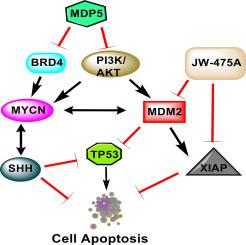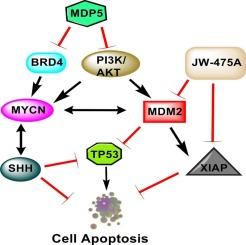Lipid nanomedicine simultaneously inhibits BRD4/PI3K and MDM2/XIAP signaling pathways for effective treatment of Medulloblastoma
IF 11.5
1区 医学
Q1 CHEMISTRY, MULTIDISCIPLINARY
引用次数: 0
Abstract
Medulloblastoma (MB) is the most common childhood brain tumor arising from the cerebellum. PI3K and BRD4 signaling pathways are known to induce MB cell growth, cancer stem cell (CSC) proliferation, and tumor resistance. Further, the tumor suppressor gene TP53 is found to be inactivated in MB due to overexpression of its negative regulator MDM2. In this study, we synthesized MDP5, a potent BRD4/PI3K dual inhibitor, and JW475A, a potent dual MDM2 and XIAP inhibitor. The combination of these two drugs significantly decreased the colony formation capacity compared to individual drugs. Given the challenge of inefficient drug transport across the blood-brain barrier (BBB), we prepared rabies virus glycoprotein (RVG) peptide decorated lipid nanoparticles (LNPs), which showed 4.9 ± 0.1 and 4.8 ± 0.1 % loading for MDP5 and JW475A, respectively. In vivo studies in mice showed that Cy5.5 labeled RVG-LNPs were detected in the brain after systemic administration. Combination drug-loaded RVG-LNPs significantly decreased the MB growth in orthotopic mouse model of MB compared to free drug combination and non-targeted LNPs. This study indicates that MDP5 and JW475A -loaded RVG-LNPs are a promising drug brain delivery system worth exploring further in clinical settings for MB therapy.


Ipid纳米药物同时抑制BRD4/PI3K和MDM2/XIAP信号通路,有效治疗成神经管细胞瘤
髓母细胞瘤(MB)是最常见的儿童小脑肿瘤。已知PI3K和BRD4信号通路可诱导MB细胞生长、癌症干细胞(CSC)增殖和肿瘤抵抗。此外,发现肿瘤抑制基因TP53在MB中因其负调节因子MDM2的过度表达而失活。在本研究中,我们合成了一种有效的BRD4/PI3K双抑制剂MDP5和一种有效的MDM2和XIAP双抑制剂JW475A。与单独用药相比,这两种药物联合使用显著降低了菌落形成能力。考虑到药物通过血脑屏障(BBB)转运效率低的挑战,我们制备了狂犬病毒糖蛋白(RVG)肽修饰的脂质纳米颗粒(LNPs), MDP5和JW475A的负载率分别为4.9 ± 0.1和4.8 ± 0.1 %。小鼠体内研究表明,全身给药后,在大脑中检测到Cy5.5标记的RVG-LNPs。与自由联合用药和非靶向LNPs相比,联合载药RVG-LNPs显著降低原位MB小鼠模型的MB生长。本研究提示MDP5和JW475A负载RVG-LNPs是一种很有前景的药物脑传递系统,值得在MB治疗的临床环境中进一步探索。
本文章由计算机程序翻译,如有差异,请以英文原文为准。
求助全文
约1分钟内获得全文
求助全文
来源期刊

Journal of Controlled Release
医学-化学综合
CiteScore
18.50
自引率
5.60%
发文量
700
审稿时长
39 days
期刊介绍:
The Journal of Controlled Release (JCR) proudly serves as the Official Journal of the Controlled Release Society and the Japan Society of Drug Delivery System.
Dedicated to the broad field of delivery science and technology, JCR publishes high-quality research articles covering drug delivery systems and all facets of formulations. This includes the physicochemical and biological properties of drugs, design and characterization of dosage forms, release mechanisms, in vivo testing, and formulation research and development across pharmaceutical, diagnostic, agricultural, environmental, cosmetic, and food industries.
Priority is given to manuscripts that contribute to the fundamental understanding of principles or demonstrate the advantages of novel technologies in terms of safety and efficacy over current clinical standards. JCR strives to be a leading platform for advancements in delivery science and technology.
 求助内容:
求助内容: 应助结果提醒方式:
应助结果提醒方式:


